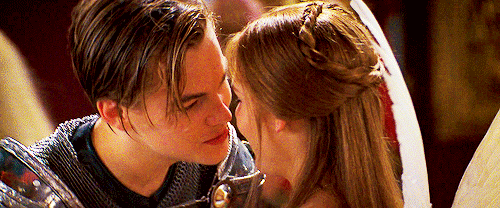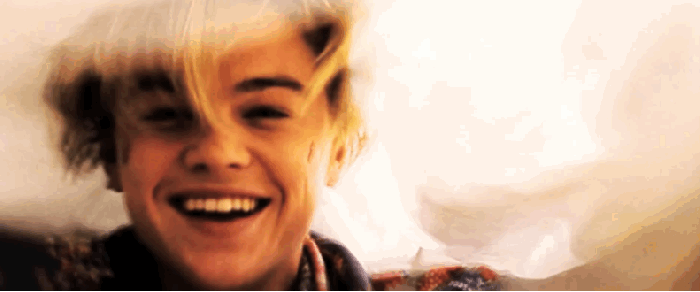This, like many questions on the internet, can probably be answered with a gif:

But this Autostraddle article only slightly ironically reviving 1990s Leonardo DiCaprio as a queer women’s style icon sums up what a lot of us, in between Romeo and Juliet and Titanic, were probably thinking.
Almost every queer woman from the 90s has a DiCaprio story: even if we didn’t yet know why.
The ideas that if I was a lesbian, I might still like watching Leonardo DiCaprio / that finding something attractive in him didn’t mean I wasn’t one / that you could want to pick up part of how he or anyone else looked because you were attracted to them, not instead of that – were all so far outside my experience that in 1996, when Romeo and Juliet came out, I didn’t even recognise him as belonging to the same category as the women and girls I was noticing, with both those contradictory impulses at once.
The idea there was some specifically queer way of noticing DiCaprio, and that by telling each other about it we’d recognise ourselves… was already coming out of feminist media studies, in those very years – Reina Lewis’s article on ‘the lesbian gaze and fashion imagery’ dates back, so appropriately in my case I almost can’t believe it, to 1997 – but nowhere near my everyday consciousness as a 14-year-old; today it would just be a few shares, retweets or last-ditch Google terms away.
The fact that we now have the technology and the connectivity for complexities of sexuality and gender identification and gender expression and everything in between to be not just revelations but tropes – not even the kind of utterance that pulls the curtain back from the world for the first time but if it’s a guy who looks like he’s dressed like a lesbian again, it must be Thursday – when that very confusion used to leave me and women my age not knowing what was up with us for years, is one of the increasingly few things that leaves me not wanting the universe to toss the last thirty years into the trash and start again.
We learned about crushes from pop magazines. Or we were meant to. These were the last years of the irreverent Smash Hits, the glory years of Just Seventeen, slices of British pop-cultural history that one day are going to be somebody’s research. (Someone had done that with Jackie before I was even born.) I couldn’t make myself interested in them; they were always about boys.
Romeo and Juliet appeared mid-1996, when the only way I knew how to say I was attracted to a woman was either to say she looked like someone else or – a sensation I was years from even being able to explain, because of everything unnameable it rested on – sometimes that I wanted to look like her. You couldn’t say that, or I thought you couldn’t sat that, about a guy, no matter how much Justine from Elastica and Alex from Blur might effectively resemble each other. DiCaprio in Romeo and Juliet, and Tim Henman at Wimbledon, were talk of the classroom; coming up a distant third, I think, was Steve McManaman.
I should have still seen Romeo and Juliet at the cinema, with my mum, except we hadn’t realised that we’d need to book. I knew it from trailers, still photographs in film reviews, and The Cardigans’ earworm of a ‘Lovefool’, which stayed on hourly rotation all summer when I wanted the radio to play Celine Dion.
Titanic, two years later, brought more of Celine Dion than almost anyone could have wanted, although not the way I wanted, which was another story; and it brought back Leo.
(I say two years; its UK release was mid-November 1997, and so we probably saw it close to Christmas, one of that set of things like ‘Torn’ or the All Saints I’ve mentally pushed into 1998 because they obviously came after, not before.)
By the time I saw Titanic, I was A Lesbian. I had to be; I’d had to admit it, because the only other explanations anyone could find for how I’d been behaving were so much worse. Lesbians fancy women. They fancy Kate Winslet, because everyone, apparently, fancies Kate Winslet, and the ones with short hair definitely would, because that’s the way that couples go together.
I didn’t have the slightest interest in Kate Winslet, or equally, by that point, Celine Dion.
Catch Leo from the back, like you hardly ever would because the camera already knew he was the star, and he’d look like someone I wasn’t meant to think about any more.
One lunchtime in I-think-it-was-still 1998 a girl canvassed the computer room we’d occupied for our school newspaper, asking for each of our top three crushes so she could make a chart. These days I like to think I’d know that I could rattle off what I’d be thinking, if I was 15 or 16 now: Ruby Rose, Scarlett Johansson, Kristen Stewart. ‘Ricky Martin,’ I blurted out, not knowing he’d be a soft-butch lesbian icon in due course. ‘Michael Owen.’
For some queer women, Leo was the safe one: the one you could talk about because everyone did, and not have to admit that what attracted you to him was what brought him closer to you across the gender boundary rather than what pushed him further away.
For other queer women, Leo was the exception: the one you could desire without threatening your queerness, when the pressure not to compromise your identity with any hint of being attracted to men was even higher than it is now, because everything that made him attractive was androgyny.
For others, Leo might have been the one you could try to be as much like as you could yet never have to let on to anyone you were a woman, because the safety net of his masculinity and his heterosexuality was always there.
And yet what made DiCaprio a star was ambiguity; before stardom and age resolved it, as it so often does.

For years I wouldn’t have known – I didn’t know – what to do with the fact that almost every photo of DiCaprio in between those films had him wearing outfits I or young women around me might have worn. (Just from that article, I had two bead necklaces like that, and at some point one of those plastic headband combs; I recognise one of his shirts so closely it makes me want to check the label; my hair never flipped over properly, though that was nothing new.) For years I didn’t see – just like I didn’t even see the tightness of Carrie-Anne Moss/Keanu Reeves’s duality in The Matrix – what oh-of-coursed its way past me as I posted that last gif, that Leo’s sandy hair and chain mail are reminding me of another icon from a few years later, Milla Jovovich in Joan of Arc. DiCaprio in the 90s looked like a lesbian, an inadequate shorthand that subsumed the whole gamut of sexuality and gender expression into one very specific, culture-bound way of being queer that still lives on as a working concept on the queer internet: some kind of affinity with masculinity, in the style of someone who hasn’t had it prescribed for them.
Almost every queer woman from the 90s has a DiCaprio story: and many of us couldn’t even imagine, then, that we’d be sharing or even understanding ours.
Oh this is so true. When I was 13, Titanic came out, but since I was so anti as a teenager I never watched it until 20 years later which was yesterday. Yet as a teenager I had my room FULL of posters of Leo’s face and I was very in love with him hahaha! And yesterday it hit me like a brick! I saw him on screen and I felt like Kate, their whole behavior together is so butch and femme, it’s crazy, and I looked at him and I was drooling, he did NOT connect with “man” in my head. He did connect with “butch” in all the best ways. And finally, I understood why as a teenager I had such a crush on him! Haha! I told my butch spouse about it while we were watching it and had a good laugh. Weirdly, now I feel queerer than ever. I know now that I didn’t have a crush on a man, my teenage self knew exactly what rocked my boat the hardest. Oops, no pun intended.
LikeLike